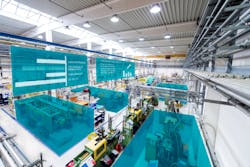RTLS is on the rise, but what is it?
By Steven Manifold, CMO, Ubisense
Real-time location systems (RTLS) have become popular in the engineering, logistics and manufacturing industries in recent years. Businesses that have a better grasp of these technologies and their potential advantages are benefiting from the improved efficiency, forecasting and safety. Also a growing number of industries, including supply chain management (SCM), healthcare, the military, retail, leisure, and postal and courier services, use RTLS-capable products. So, what are they?
What is RTLS?
RTLS stands for real-time location system. These systems are designed to track vital assets in real-time, building up a picture of what is happening within a complex process. RTLS can be built from a variety of asset-management and location systems, not a particular system or technology. The time at which assets are tracked is a crucial component of RTLS, and depending on the application, this data can be used in a variety of ways, including precisely locating and managing its targeted assets (inventory, machines, vehicles, people). It will also assist businesses in making optimizations to their working systems, as well as enabling predictive analytics.
Aspects of an RTLS
There are several key aspects to an RTLS, including: real-time tracking, trends & forecasting, automation, and geo-fencing. There are numerous varieties of RTLS solutions available, and each will fare differently at these tasks. Others are relatively new and have advantages over more established systems, while some, like BLE technology, have been around for a while.
Passive RFID, active RFID, rnfrared (IR), Wi-Fi positioning, BLE (Bluetooth low energy), and UWB (ultra-wideband) are some of the more popular types of RTLS systems. UWB tends to be used for more precise location systems, while BLE is better for more cost-effective RTLS, including geo-fencing operations. BLE makes use of tags (commonly known as beacons) and sensors (anything with Bluetooth capabilities).
The three main components of RTLS that gather and combine all the data are the transmitters, the sensors, and the software.
· Hardware: Transmitters (tags, badges, and transponders) can differ in size and performance. In general, there are two types: passive (which picks up radio waves from nearby "exciters") and active (which need power from a battery or an external power source). By sending a signal to sensors, they allow the object or person they are attached to to be identified. RFID tags, UWB tags, BLE & Wi-Fi tags, smart devices, and GPS tags are a few examples.
· Sensors (receivers): The sensors used to track tags will differ depending on the types of tags used. In most indoor environments, active RFID, Bluetooth low energy, or ultra-wideband technology can be used to meet more complex tracking requirements than can be supported by simple passive RFID tags.
· Software: RTLS technology uses a variety of software systems, such as middleware, that decodes the location data stream and connects to external applications, firmware on hardware objects (sensors, tags or both), and data-visualization software. Businesses looking to use RTLS technology will be most interested in the software in the external applications, as it will determine how they will work with RTLS. The application software can vary significantly depending on the industry.
Location indicators are crucial pieces of data that aid RTLS software in pinpointing the tagged assets. Time, angle of arrival, and RSSI are the most typical examples.
RTLS in industry
The use of RTLS technology in a wide range of industries is becoming popular, as awareness of the technology grows. RTLS technology is currently utilized in a variety of sectors, including the automotive, aerospace, defense, MRO (maintenance, repair, operations), transit and depot management, tool control, warehousing, healthcare, worker safety, and numerous others. The following are some typical problems being resolved:
· Stakeholders can increase productivity and safety by tracking everything inside a facility, from minor components to large pieces of equipment.
· WIP (work-in-progress) management across a facility can stop late deliveries and lost or damaged goods.
· A transit yard can be made more efficient by automating time-consuming tasks and reducing wasted search time by accurately tracking the location of vehicles in real-time.
· In the aerospace industry, time and cost associated with complex production processes can be decreased with the tracking of aircraft assembly, tooling, kits and parts.
· One centralized platform can be used to manage production logistics, worker safety, and tool management.
· Tool operations can be automated by tracking the location of wireless tools and vehicles on a production line.
· Employees can wear small tags or affix them to their equipment. Some RTLS systems’ high accuracy enables them to send alerts when workers are in close proximity to one another. A company's downtime during pandemics can be significantly decreased with careful contact tracing.
While this is just a brief introduction to the topic of RTLS, hopefully the above has given you some ideas about how this technology could be applicable to your industry.
